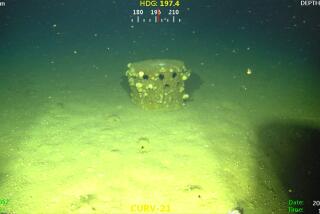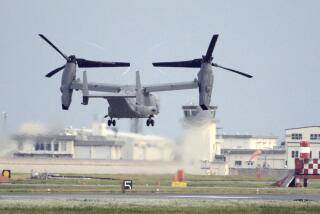Navy Locates Wreckage of Japanese Boat That Sub Sank
- Share via
WASHINGTON — A deep-sea vehicle probing the Pacific Ocean near Honolulu located the wreckage of a Japanese fishing boat that sank after it was struck by a U.S. nuclear submarine, officials said Saturday.
The find came nearly 13 hours after the Navy’s deep-diving robot, Scorpio II, departed Pearl Harbor on Friday morning in search of the Japanese trawler Ehime Maru. Nine of the 35 people who were aboard the boat are missing and presumed dead.
There were no immediate signs of bodies in the vicinity of the vessel, which lies upright at a depth of 2,003 feet, just 1,000 yards from where it collided with the attack sub Greeneville.
But its discovery intensified pressure on the Navy to undertake the enormous task of recovering the boat from the ocean floor.
In Japan, government officials and victims’ relatives renewed their request that the wreck be raised and the bodies located.
“[Finding it] is the first step toward raising it, although there will be many other things that have to be taken care of,” said Moriyuki Kato, governor of Japan’s Ehime prefecture. “I hope this will ease the [victims’] families’ feelings, even a little.”
During talks with U.S. Ambassador to Japan Thomas S. Foley last weekend, Prime Minister Yoshiro Mori had urged the U.S. to raise the vessel.
At the Pentagon on Saturday, a Navy spokesman said Navy officials are “still looking at” the possibility of raising the trawler and plan more analysis of the boat’s position and location to try to determine if a salvage operation could be successful.
“All options are open,” Capt. Joe Gradisher said.
In another recent submarine calamity, Russia has spent millions in an attempt to retrieve the remains of the 118 sailors who died when the nuclear submarine Kursk exploded in August and sank 350 feet below the surface of the Barents Sea, 85 miles off the Arctic port of Severomorsk. The 500-foot-long Oscar II class sub remains under freezing waters, awaiting a salvage operation in the spring.
But the Japanese trawler, while lighter, is a considerable distance deeper than the Russian sub. The huge pressures involved at 2,000 feet--more than a third of a mile deep--add considerable complication to the recovery job, Gradisher said. “There’s a lot of physics involved.”
Investigators are seeking to determine why the Greeneville, which is outfitted with sonar and a high-powered periscope, apparently did not know that the 499-ton, 190-foot-long trawler was directly above it when the sub surfaced during an exercise.
The fishing vessel sank minutes after the Greeneville breached the ocean’s surface during an emergency rapid-ascent drill. Two civilian guests were at control stations of the sub during the maneuver.
Still missing are four students and two teachers from a Japanese vocational high school, along with three crewmen who were aboard the commercial fishing trawler. In all, 26 people were rescued after the Feb. 9 accident.
The trawler was found on the ocean bottom at 11:25 p.m. Friday, said Petty Officer Sean Hughes, a spokesman for the U.S. Pacific Fleet.
Within minutes, Hughes said, Navy officials summoned a second submersible with deeper diving capabilities, called Deep Drone, to assist the Scorpio, which is equipped with sonar and two video cameras. Neither vehicle is manned.
Hughes said it was unclear how long the survey of the wreckage site would continue. However, Coast Guard Capt. Steven A. Newell told the BBC on Saturday that the search would continue through at least Monday afternoon. By that time, Newell predicted, search aircraft and ships will have probed almost 6,500 square miles of ocean--an area about the size of Hawaii.
No one could be reached for comment Saturday at the Japanese consulate’s office in Honolulu. But 16 anguished and tearful family members of the nine people missing held a news conference Friday to demand that U.S. officials tell them how and why the crash occurred.
At the vocational school the students attended in Uwajima, news of the boat’s discovery brought some relief. “It’s a small solace in a deep grief,” Principal Ietaka Horita said, according to a school spokesman.
But there is continued anger in Japan concerning the accident, because the U.S. has not followed culturally significant apology etiquette. While Secretary of State Colin L. Powell apologized directly to Japanese Foreign Minister Yohei Kono and President Bush has made an apology to the people of Japan in a public speech, Bush has not called Mori directly to offer condolences, as many in Japan expected him to do.
The Navy and the National Transportation Safety Board are conducting separate investigations. NTSB personnel, who have interviewed four of the 16 civilians about the Navy submarine and about half a dozen military personnel, still were on the scene Saturday but planned to leave Hawaii today.
“We plan to talk to more of those involved . . . but it may take a year or more before” a full report is issued, NTSB spokesman Keith Holloway said.
*
Times staff writers Paul Richter in Washington and Valerie Reitman in Tokyo contributed to this story.
More to Read
Sign up for Essential California
The most important California stories and recommendations in your inbox every morning.
You may occasionally receive promotional content from the Los Angeles Times.










